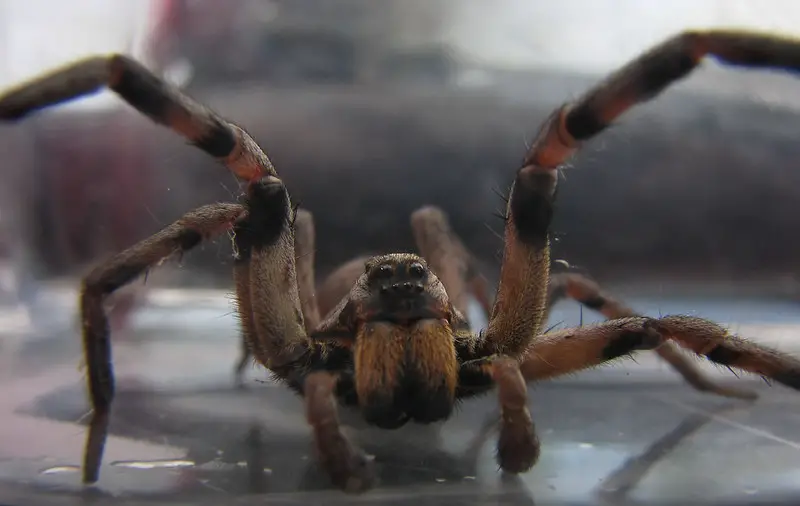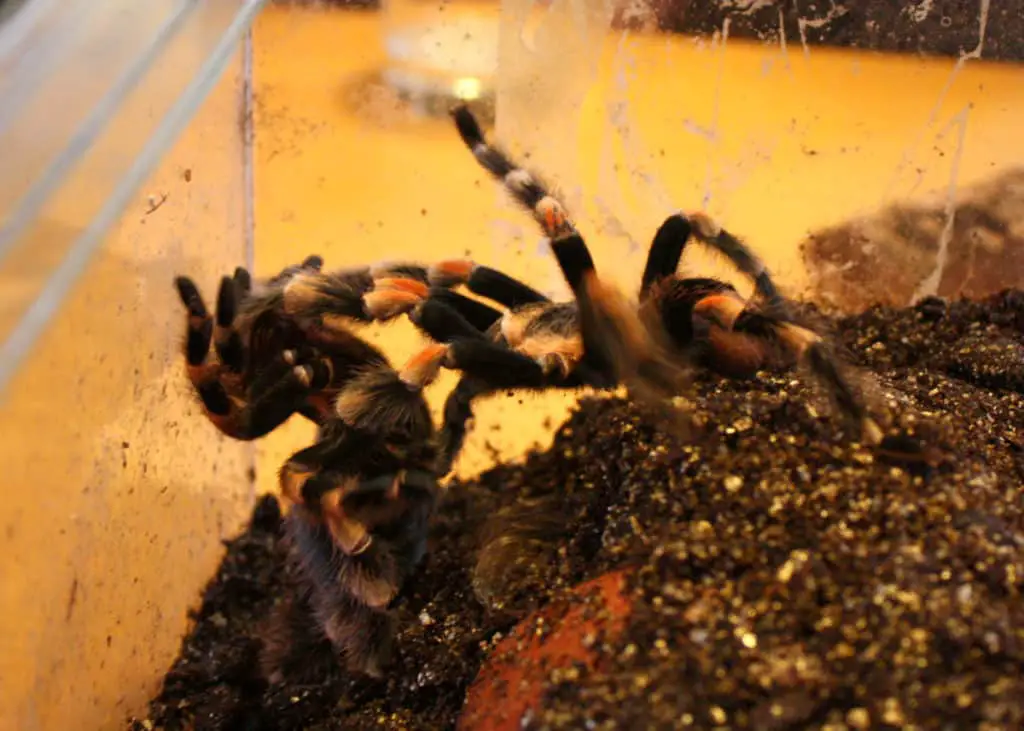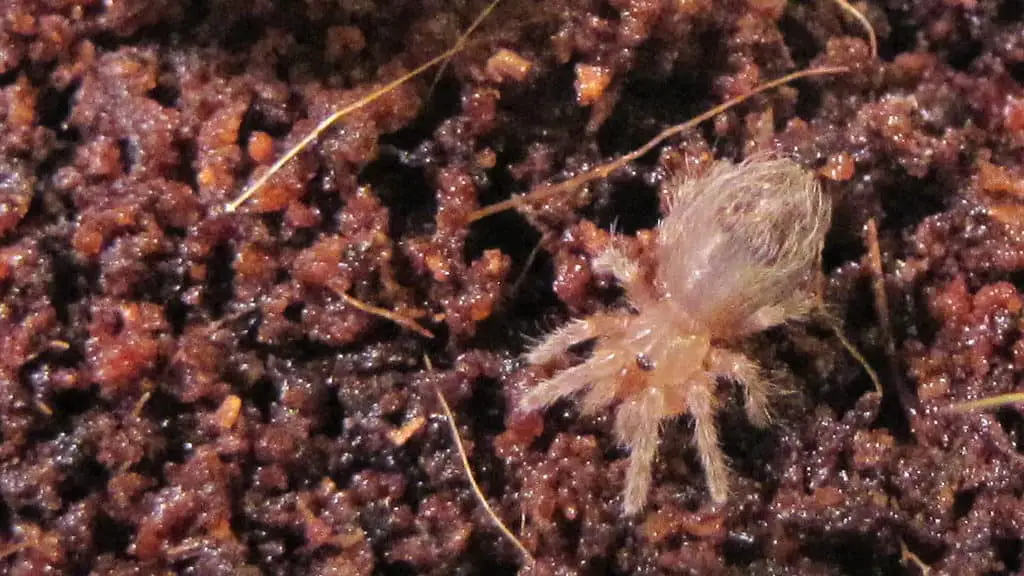At some stage, you might want to try breeding your tarantula either for fun or to earn some pocket money. This guide will teach you how to breed tarantulas, focusing mainly on terrestrial species.
To breed tarantulas, place a male and female adult in a large container. Remove the male tarantula after mating. Gravid tarantula lays her eggs and keep them in an egg sac. Transfer the hatched spiderlings into jars and feed them with flightless Drosophila. Separate them into individual containers once they grow larger.
Breeding tarantulas is definitely challenging, but not impossible with enough patience, determination, and preparation. Before going into detail, make sure you are already familiar with handling tarantulas (check out my guide on keeping tarantulas if you are new in this).
Preparing Male and Female Tarantulas
How to Sex the Tarantulas
Obviously, you will need both male and female tarantulas to breed them. But most likely, you only have a female tarantula (since many prefer to keep a female due to her long lifespan).
Fortunately, many tarantula keepers are willing to loan their male tarantula for breeding. The usual arrangement is to share half of the offspring produced. Alternatively, you can buy a male tarantula if you need one.
If you have a male tarantula instead of the female, you can also send it for a mating trip. Just bear in mind that your tarantula might become a meal of the female tarantula.
An experienced seller would be able to tell you the sex of your tarantula upon purchase if the tarantula is old enough. If the tarantula was too young to be sexed at the time of purchase, you will have to do some studies to determine the sex of your tarantula, which is a difficult task!
So, how do you identify the sex of your tarantula?
The most accurate way to determine the sex of a tarantula is by examining its molted skin. You should be able to find the spermatheca on the female tarantula’s molted skin.
There is a great post here that teaches you how to check the spermatheca. You need at least a magnifying glass (preferably a microscope) to correctly identify the sex of the tarantula.
Some tarantulas have different colored male and female, which can be easily distinguished. For instance, Aphonopelma moderatum male is dark in color while the female is brownish-orange.
Are Your Tarantulas Sexually Mature Adults?
Don’t be too happy after you have successfully sexed your tarantula. You need to ensure that your tarantula is sexually mature. Tarantulas are sexually mature only after the ultimate molt where they turn into adult, also known as the ultimate instar.
Adult female tarantulas have sclerotized spermatheca. You can find darkened spermatheca on the molted skin from the ultimate molt; Adult males have swollen emboli. Adult males of some species have tibial hooks (also known as apophyses) on their legs.
Emboli are the swollen portion at the tip of the pedipalps. If you don’t know what pedipalps are, those are feelers of tarantulas. Pedipalps are located before the first pair of legs. They resemble legs but they are way shorter.
The male tarantula loads its sperms onto the emboli and uses the them to deposit the sperms onto the spermatheca of a female tarantula. Emboli are sometimes known as the “boxing gloves” due to its shape.

Confirm the Species of Your Tarantulas
One last thing before we proceed, be sure that the male and female tarantulas are of the same species! No matter how similar they are from appearance, tarantulas of different species cannot produce viable offspring.
To avoid confusion, always use scientific names instead of common names when addressing the tarantulas. For instance, both Brachypelma smithi and B. hamorii are known as Mexican redknee but they can’t interbreed.
Age of the Tarantulas
Generally, the younger the adult tarantulas, the better their fecundity and fertility. Using a younger adult tarantulas will increase the success of breeding.
In case you don’t know, adult female tarantula can continue to molt. Do not use a female tarantula which is about to molt.
Preparation before Mating
After having both the adult male and female tarantula of the same species, you will need to prepare rooms for them. For the female tarantula, get an enclosure or housing double the size of her normal enclosure.
Prepare the enclosure and house the tarantulas like how you would normally do with a few exceptions: higher humidity and slightly warmer environment. Simply add an additional water dish and place the tarantula somewhere warmer in your house. You don’t have to use any additional heating method.
Keep the tarantula in the dark and let them acclimate to the new environment.
Male tarantulas require lesser substrates. They are ready to mate after you see them spinning a sperm web. Sperm web is basically a web where the tarantula spray their sperms onto. The male tarantula will then rub its pedipalps on the sperm web to pick up the sperms. After that, the sperm web might be destroyed.
Prepare a pair of bamboo chopsticks, some palm-size cardboards, a soft penbrush, and a transparent cup with a lid. Make a small hole at the bottom of the cup so the penbrush can pass through.
Lastly, make sure the tarantulas are well-fed to reduce the chance of female tarantula perceiving the male as food.
Tarantulas Mating
Mating of tarantulas is best done in the evening. Look for a spacious spot in your house and place both the tarantula housing on the floor.
With your gloves on, carefully coax the male tarantula into the cup prepared earlier and transfer it into the female housing. Gently push the male tarantula out using the penbrush through the opening on the cup made earlier. Make sure the male tarantula lands as far from the female as possible.
The male tarantula will slowly approach the burrow and attempt mating. When the female tarantula senses the male, she will either accept the mating request or attack the male. Be ready to stop the attack by using the bamboo chopstick or cardboard prepared earlier. Note that it is very difficult to differentiate acceptance and rejection to the mating request though.
If the conditions are right, the female will accept the mating request of the male tarantula. You should see them “hugging” and the male will transfer his sperms from the pedipalps onto her spermatheca.

Watch carefully. Once you see the male tarantula complete his task and disengage the female, quickly remove him before the female starts to attack him.
Let the male tarantula rest until he constructs a new sperm web. Then, you can repeat the mating process to increase the chance of pregnancy. You can mate the female with more than 1 male to diversify the genetics of the offspring.
Why won’t My Tarantulas Mate
There are occasions where the male shows no interest in the female or vice versa, or both. The female tarantula will attack the male if she is not in mood. Quickly take out the male if that happens.
There are a few reasons why the tarantulas are not interested in mating:
- The tarantulas are not sexually mature. Check and confirm that both tarantulas are adults (refer to Getting the Bride and Groom section).
- The tarantulas are of different species. Make sure the male and female tarantulas are of the same species by confirming their scientific names.
- The female tarantula is gravid or pregnant, or she has laid eggs in the current instar. A pregnant female will refuse to mate until after the next molt.
- The conditions are not right. Make sure you have dimmed the light and minimize any air movement.
How to Increase the Chance of Successful Mating in Tarantulas
To increase the chance of successful mating you can try to “scent” the tarantulas.
Take a bamboo chopstick and dip into the substrates inside the dwelling of the male to pick up the scent of the male. Make sure you use the substrates from the original housing and not the new housing, because the new housing may not have enough “scent”.
Rub the chopstick at the pedipalps of the female so that she can pick up and get familiar with the scent. Do the same for the male tarantula using a new chopstick to pick up the female’s scent.
For non-burrowing species, if everything is right but the male tarantula is still not showing interest in mating, you can try to move the female tarantula to the male’s housing instead. Be sure the housing is big enough for both tarantulas to move around. Mating can miraculously happen with this move. No one knows the exact reason though.
Another way to deal with male tarantula with lower sex drive is to put it in a “shark cage”. For this method, you need an enclosure with a grill lid just enough to house the male tarantula, and a bigger enclosure that can house both the smaller enclosure and your female tarantula.
House the male tarantula in the smaller enclosure with normal setup, except the enclosure is laid on its side. Place the male enclosure at the corner of the bigger enclosure containing the female and let it sit there for 1-2 days. Make sure the grill lid is secured enough.
The idea is to let the male tarantula get familiar with the scent of the female and to trigger his desire to mate. Once you release the male, you should see him attempting to mate.
Caring for Gravid Tarantula
House the gravid or pregnant tarantula into a thoroughly cleaned enclosure to remove any molds or mites. The enclosure should be set up like what you normally would – with enough substrates to burrow and a coconut shell to serve as a cave.
The gravid female has a bigger appetite. She eats more and grows bigger. Make sure you provide her enough food.
It takes a few weeks (for tropical species) to a few months for the tarantula to begin laying her eggs. The female will usually spin a lot of webs and hide inside the cave or burrow to lay eggs. Just let it be and don’t disturb her. You don’t have to worry about food once she hides inside the web.
You might be surprised to see your tarantula excreting some thick liquid from her opisthosoma. This liquid contains her eggs. The tarantula will roll her eggs with her web and some substrates into an egg sac. Let the mother take care of the egg sac until the eggs hatch.
Make sure you keep the substrate moist. Carefully mist or water the substrates around the female and the eggs but not directly on them. Cover some vents on the enclosure to preserve the humidity.
Taking Care of the Spiderlings
When the eggs hatch, the first instar spiderlings will stay in the eggs and feed on the nutrients inside. They disperse only after the next molt. This is where you need to separate them from their mother.
Prepare a few transparent 1-gallon jars and fill the jars with coir up to 2 inches in depth. The coir should be moist enough so that when squeezed it briefly holds its shape without dripping water.
Carefully transfer the spiderlings into the jars, with approximately 100 spiderlings per jar.
Cover the opening of the jar with 2 layers of cotton handkerchiefs and tie them with 2 rubber bands. You need to use 2 rubber bands so that if 1 breaks, there is a backup to prevent the spiderlings from escaping.
The spiderlings should be placed somewhere dark in the room temperature. You can increase their growth rate by putting them somewhere warmer.
On a weekly basis, feed your spiderlings with flightless fruit flies or pinhead crickets. Each spiderling needs 4-6 of those.
Separating the Spiderlings
Tarantulas are carnivores, and they can cannibalize each other, especially after they grow into 3rd or 4th instars. Hence, you will need to separate them sooner or later.
To separate the spiderlings housed in a jar, put the jar into a storage box. The storage box serves as a moat so that you have better control over the situation if the spiderlings break loose.
Pour some substrates out of the jar into the storage box. Carefully capture the spiderlings and place them inside individual bottles or containers. Those containers should be laid with moist coir beforehand and have vents on them.
The exact timing to separate the spiderlings depends on your capacity. Tarantulas can lay up to thousands of eggs. Can you manage 800 spiderlings? Or 300? Although it sounds cruel, separating the spiderlings later can reduce their numbers to a manageable level. Having said that, it is always a good idea to sell or gift the extra spiderlings to others.
If you want to make a business from breeding tarantulas, you can separate each spiderling into individual bottles in the first place when they disperse from the egg sac. That will minimize losses from cannibalism.
Continue feeding the tarantulas with bigger prey and transfer them to bigger enclosures as they grow.
Recommended Supplies
Here’s my recommended supplies for your tarantula breeding project. Note that I get a small commission when you buy the items through the links in this page. This helps me to maintain the site without incurring additional costs to you.
Final Words
It takes a lot of effort and some luck to successfully breed tarantulas and take care of the young spiderlings or juveniles. If it fails tragically, don’t be demotivated. Carefully think about what may have gone wrong and try again.
I hope this guide is helpful and worth your time. Do check out my recommended books on tarantulas if you want to learn more about keeping tarantulas as pets.



